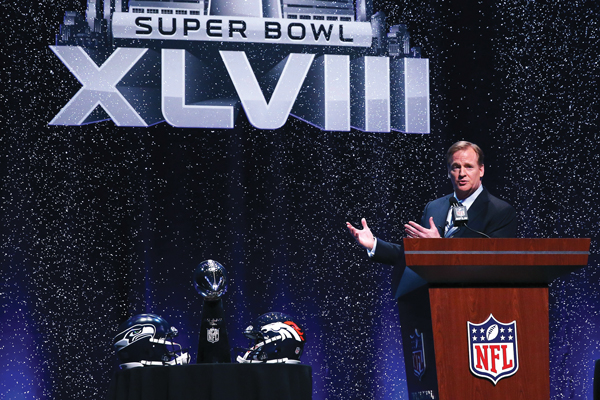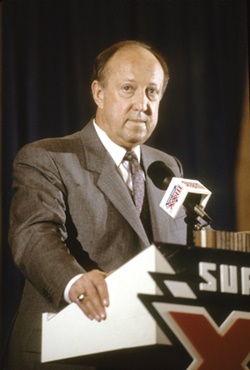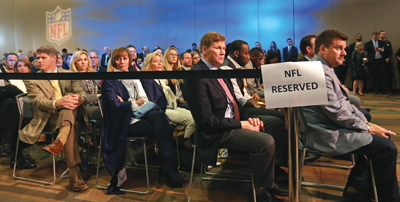 |
Special effects have included the creation of virtual snow around Commissioner Roger Goodell in 2014.
Photo by: GETTY IMAGES
|
The NFL commissioner’s Super Bowl press conference has grown significantly since Pete Rozelle invited a handful of reporters up to his suite at the Statler Hilton in Los Angeles days before Super Bowl I in 1967. The game wasn’t called the Super Bowl then (Rozelle never liked the name), but it quickly grew, and along with it the formal press conference, the first of which came at Super Bowl III.
In recent years, the room is filled with hundreds of people, if not over a thousand, and the stagecraft, with large video screens and even stunts like fake snow during the New York event, has made it a must stop for the elite of the sports business.
 |
Pete Rozelle (shown in 1989) began the tradition informally in 1967, and it grew through the administrations of Paul Tagliabue (below) and Goodell.
Photo by: GETTY IMAGES (2)
|
But that growth could slow now that the league has made perhaps the biggest change since Rozelle in his hotel suite pulled up a chair backward, sat down, lit a cigarette and asked for questions. The event this week is moved for the first time to Wednesday, not Friday. That means fewer league business partners, fewer owners, fewer team officials and fewer reporters will be in the room because typically many do not arrive in the host city by midweek. The attention of many members of the media will still be on player interviews.
One team owner, requesting anonymity and speaking before the change, questioned why even have the news conference given it often provides negative headlines just days before the league’s biggest day, suggesting motive for the change. The league offered a different reason, explaining that by Friday everyone is focused on football; though the importance of the event in the past appears to belie that assertion.
Moving to Wednesday could be a measure to put a lid on the event’s growth. While ESPN and NFL Network will still televise it, and hard questions will get asked, the room is likely to be lighter, not just in terms of numbers but in who attends.
Joe Browne, the former PR guru for the league who has attended every Super Bowl since the second, said he pushed for the change 15 years ago. His reasoning was the event had become theater.
“There was no hard news coming out of it,” he said. “You have a Mexican reporter asking the obligatory question, ‘When are you going to play a regular-season game down in Mexico City?’ You have the English reporter asking ‘When are you going to have a team in London?’”
Browne said his personal record during the press conference preparation with the commissioner was guessing correctly 85 percent of the topics of the coming questions.
And there are a lot of obligatory questions asked every year, in addition to planted ones like the annual query from a child who won a Play 60 contest. (Play 60 is the league’s program to encourage kids to get an hour of activity a day).
Two years ago in Arizona, in response to the Play 60 question asking did he get an hour of exercise that day, Goodell felt compelled to answer, perhaps boastfully, that he had gotten a few minutes more than that amount that morning.
Under Goodell, the news conference is often known for negatives. At the same Super Bowl press conference in 2015, he is better remembered for parrying with ESPN reporter Rachel Nichols over her questions about the league’s domestic violence investigation.
Last year, trying to articulate that only watching TV was not healthy, Goodell seemed to argue that sitting on a couch is more dangerous than concussions suffered playing football.
 |
The schedule change could mean fewer NFL owners, execs attending.
Photo by: GETTY IMAGES
|
Now, if a similar flub occurs at the midweek event, it may die out by the end of the week.
Goodell can at least be thankful he hasn’t been subpoenaed at Super Bowl news conferences. Rozelle twice had the honor. Super Bowl V was in Miami and a local lawyer, Ellis Rubin, sued the league over its TV blackout rules, and subpoenaed Rozelle, Browne recalled. The commissioner had to testify in court the next day.
And then in the most famous example, Raiders owner Al Davis subpoenaed Rozelle before Super Bowl X over the league’s effort to keep the club out of Los Angeles.
Owners first started showing up at the news conference after 9/11, said Jim Steeg, the former head of events for the NFL. In recent years, a good quarter to a third of the league’s 32 owners could be counted on being in the room. With the commissioner’s annual Super Bowl party scheduled for Friday evening, many timed their arrival to attend that event.
Some have been regulars like John Mara from the New York Giants, the Rooneys from the Steelers and Arthur Blank from the Falcons. But many almost never show, such as Jerry Jones of the Dallas Cowboys, Stan Kroenke of the Los Angeles Rams and Daniel Snyder of the Washington Redskins. Now that number of owner no-shows looks to climb.
Mara, asked about owner turnout given the day switch, replied, “Probably not as many. I don’t get there until Thursday.”
The other major leagues generally don’t have a major news conference like the NFL’s. Unlike the Super Bowl, the other leagues’ championships sites are not known until days before the event, so room size is an issue. And because of the number of games, the leagues tend to make their commissioners available throughout the championships and other events, such as award presentations.







